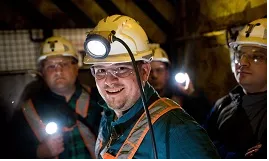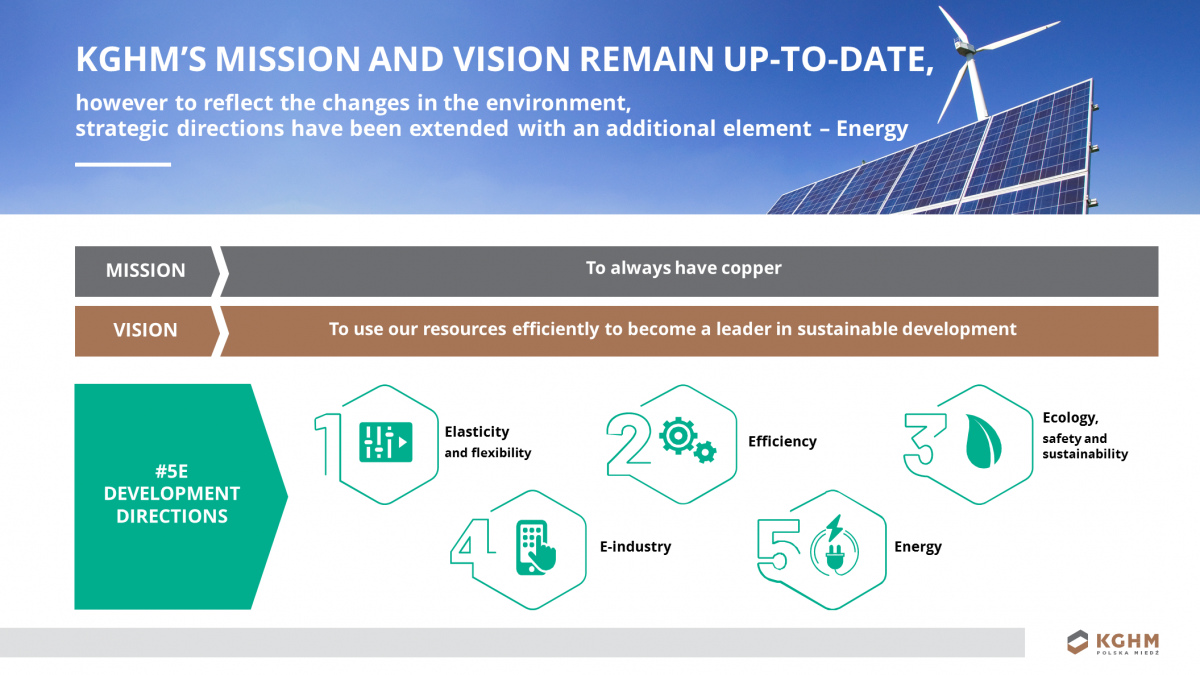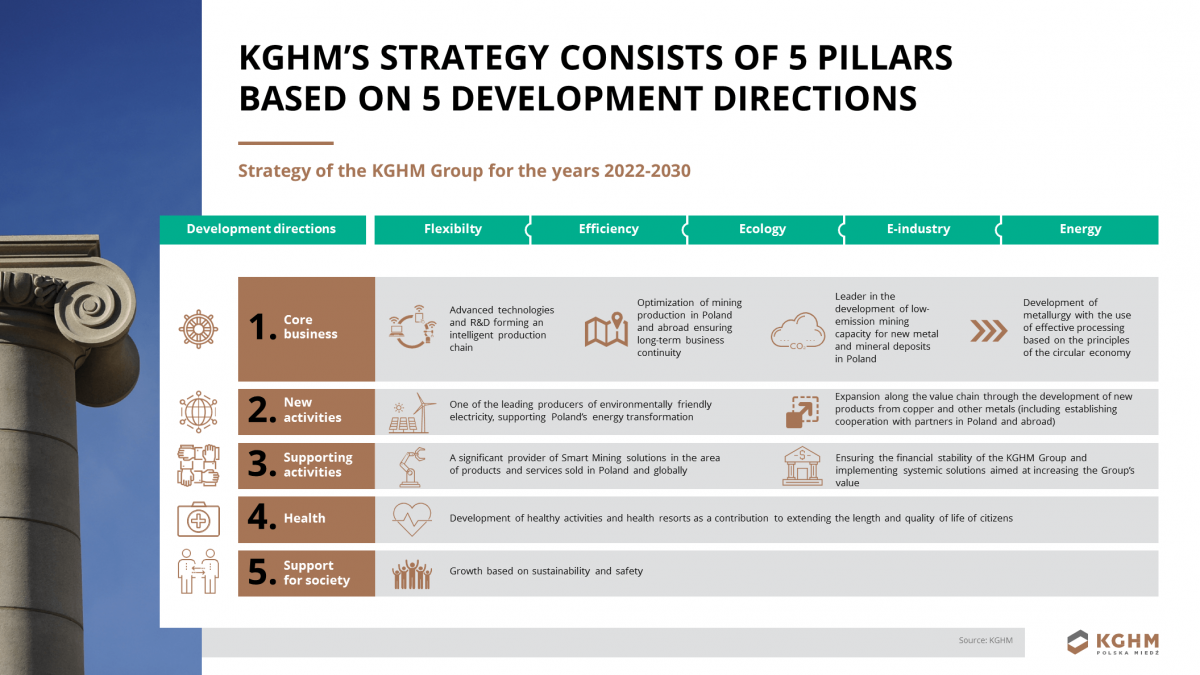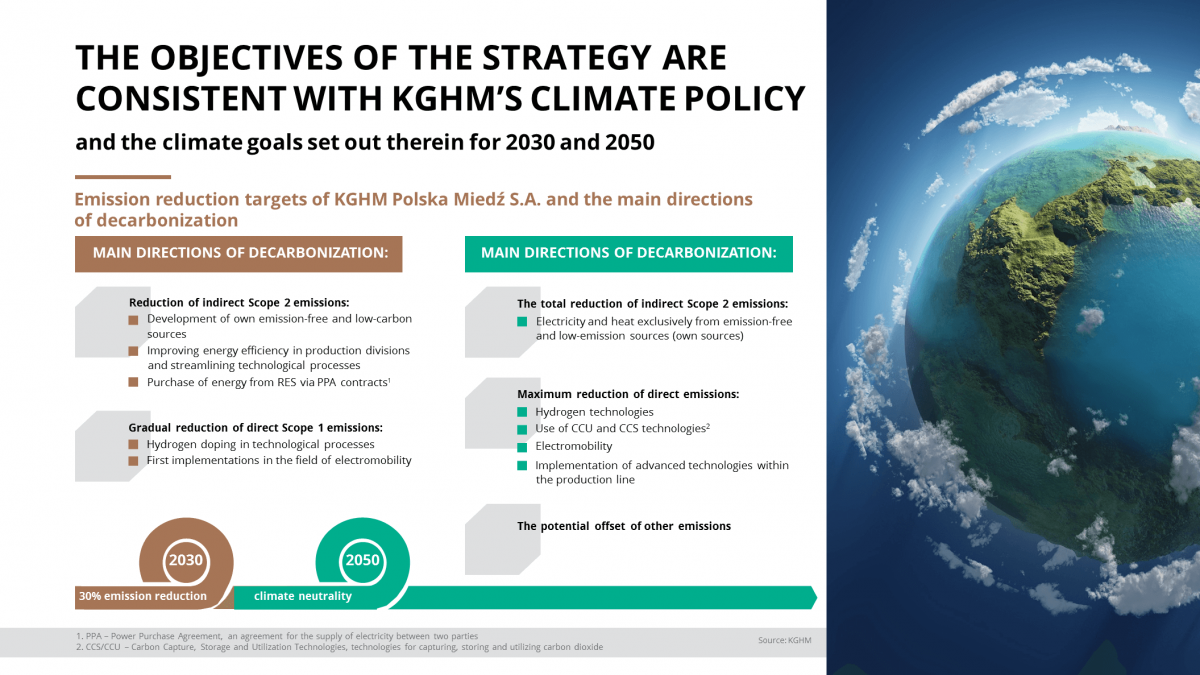The consistent advancement of the Strategy of KGHM Polska Miedź S.A. adopted in 2018 enabled the KGHM Group to take advantage of favourable macroeconomic trends to increase the scale of its activities as well as to substantially improve its production results and financial condition. As a result of the substantial changes which have occurred in the world during this time, the strategic assumptions were reviewed and refreshed. The decision to update the Strategy was dictated in particular by:
- macroeconomic changes of strategic importance for the mining sector, in particular those arising from the green transformation,
- the need to clarify the Company’s actions as regards the commencement of decarbonisation and commitments to protect the climate,
- a focus on securing access to the raw materials base for future copper production, but also actions aimed at developing mining capacity in terms of other metals and mineral resources,
- the intensification of actions aimed at the implementation of innovation in the production process,
- the identification of opportunities to gain competitive advantages and to develop the Company in new, promising business areas.
The justification for this review and redefinition coincided with an extraordinary market situation driven by the SARS-CoV-2 epidemic. Despite the fact that KGHM was exceptionally successful compared to other companies on the market during this difficult time, the desire to maintain its flexibility requires an update for plans regarding the future. The result of the Company’s work is the Strategy to the year 2030 with an outlook to 2040. The Company’s mission and vision remained unchanged.
To reflect the changes in the general environment, the four existing strategic development directions (Flexibility/elasticity, Efficiency, Ecology and E-industry) were updated to include a fifth element – Energy.
This „5E” Strategy is now comprised of 5 pillars based on 5 updated development directions.
To enlarge the image, click on it.
The Strategy of the KGHM Polska Miedź S.A. Group identifies, inter alia, climate targets related to the reduction of emissions by KGHM Polska Miedź S.A., consistent with the Climate Policy of KGHM Polska Miedź S.A., i.e.:
overarching goal: for the Company, as the Parent Company of the KGHM Group, to achieve climate neutrality by 2050 with respect to Scope 1 and Scope 2 greenhouse gas emissions, with their maximum possible reduction (supplemented by potential offsetting of other emissions),
Intermediate target: to reduce combined Scope 1 and Scope 2 emissions by 30% by 2030 compared to 2020 emissions.
At the same time, there is an Environmental Policy Department in KGHM Polska Miedź S.A., responsible, inter alia, for the coordination and monitoring of the implementation of the Climate Policy of KGHM Polska Miedź S.A. in the Group. The decarbonization program of KGHM Polska Miedź S.A., adopted in 2024, which presents the key areas of the Company's process line responsible for greenhouse gas emissions, follows and details the manner of achieving the objectives of the Climate Policy and the strategic objectives. The main direction of decarbonization in this area will be a gradual shift away from the use of electricity sourced from the market and generated using fossil fuels to the increasing use of own low- and zero-carbon sources of electricity and heat. The development of own renewable sources of electricity generation will include the construction or acquisition of renewable energy installations (photovoltaic power plants and wind power), from which the electricity generated, in accordance with the assumptions of the Company's Energy Transformation, will be consumed in 100% in the processes of the Main Process Line of KGHM Polska Miedź S.A.".
On the basis of this information and the Company's development plans, tasks have been defined and areas for which action is required to ensure the transition to a climate-neutral economy by 2050 have been determined. The Company's actions in the 2030 perspective are geared towards reducing indirect emissions, i.e. emissions associated with the use of electricity. Improving energy efficiency will also play an important role in the decarbonization process. The ISO 50001-compliant Energy Management System implemented by all Divisions is systematically influencing the reduction of Scope 2 greenhouse gas emissions. As part of the main directions of limiting the carbon footprint in the area of direct emissions of KGHM Polska Miedź S.A., it is planned to implement the CCS/CCU installation in the smelter production line, and activities in this respect will be carried out successively in the perspective of 2050.
KGHM Polska Miedź S.A., as an organization aware of the impact of climate change on its business activities, has fully integrated climate risk management into the Corporate Risk Management process of the KGHM Polska Miedź S.A. Group, whose objectives are consistent with the adopted Strategy of the KGHM Polska Miedź S.A. Group.
The division of powers and responsibilities relating to the management of corporate risks, including climate risk, applies the principles of good corporate governance practices and the widely recognized three lines of defense model:
The Supervisory Board (Audit Committee) monitors the level of key risks and how risks are handled,
The Management Board is ultimately responsible for the risk management system and oversight of its various elements,
The Corporate Risk Management and Compliance Department is part of supporting the effectiveness of the 2nd Line of Defense risk management process.
The negative impact of climate change on the operations of the KGHM Group is analyzed using the classification adopted:

The KGHM Group assesses climate-related risks and their impact on its operations on an ongoing basis as part of the Corporate Risk Management process of the KGHM Polska Miedź S.A. Group, which is described in more detail in The Management Board’s report on the activities of KGHM Polska Miedź Group in 2024 (pages 39-61). Reporting of key corporate risks of the KGHM Polska Miedź S.A. Group, including climate-related risks, to the Management Board of KGHM Polska Miedź S.A. and to the Audit Committee of the Supervisory Board of KGHM Polska Miedź S.A. takes place on a cyclical basis. Climate-related risks are described in more detail in The Management Board’s report on the activities of KGHM Polska Miedź Group in 2024 (pages 219-224, 234-236), including, among others:
scenario analyses in climate risks,
climate risk assessment in the short, medium and long term,
the results of the resilience analysis, including the results of using scenario analysis.
At the same time, the strategic management process is accompanied by an appropriate risk analysis that takes climate risks into account. The identification of risks as part of the strategic management process aims to take into account the context of the organization in an integrated manner and provide information on the risks associated with the implementation of the Strategy in specific areas. In line with the process in place, a Strategy Risk Map is prepared and presented annually as a graphical representation of the results of the risk assessment. The Strategy Risk Map taking into account climate risks contains an evaluation of the impact of the climate change risks identified in KGHM on the individual strategic areas in three time perspectives within the framework of the scenario analyses used. The approach used allows for appropriate adjustment and updating of the strategy and business model to climate change and related activities in this area related to the selection of the scope of individual strategic initiatives and projects.
Identified risks at the strategic level are decomposed into a corporate risk level and a project and program risk level, which enables effective management of individual risks. As part of the corporate risk management process, an element that provides another important tool to enable KGHM to adapt and adjust its strategy and business model to climate change is Adaptation Actions as part of Stage IV of the process (Analysis and Response). Adaptation Actions are understood as a change in the way a given risk is managed, i.e. organizational, process, system, strategic and other changes aimed at reducing the level of that risk.








